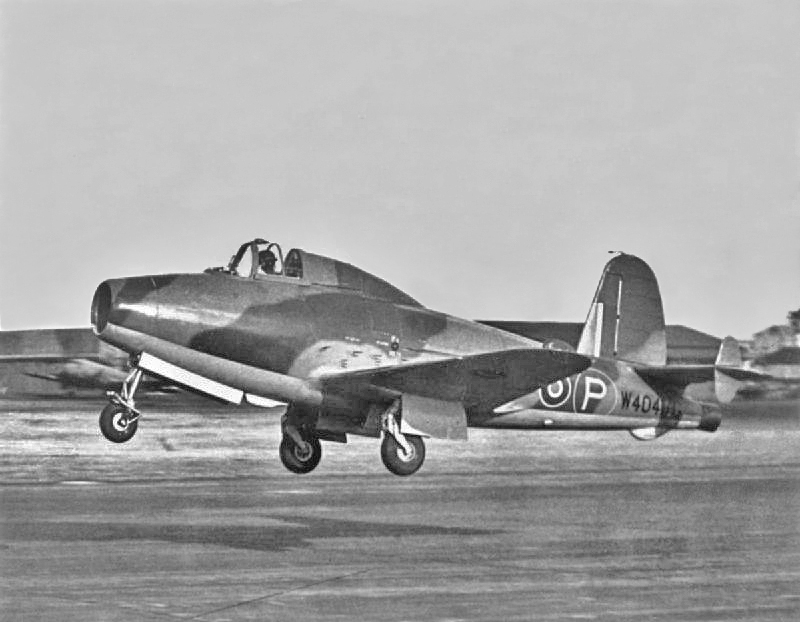Christmas Corner's Secret

The Gloster E28/39 Pioneer W4041
RAF Edgehill, which was commissioned as long ago as October 1941, was a satellite airfield for the Moreton-in-Marsh Bomber Command 21 Operational Training Unit, finally being closed as an RAF station just twelve years later in 1953. Today the site houses one of Britain's premier GoKart circuits as well as being home to Shennington Gliding Club
However, during it's wartime service, RAF Edgehill had an important and unique part to play in the development of Britain's first jet fighter aircraft. The Gloster E28/39 Pioneer W4041 - the Whittle jet - had first flown at Cranwell in 1941, but in 1942 Edgehill was selected as the base for flight tests due to its proximity to the manufacturer's Gloster and Power jets manufacturing site. It is interesting to note that the first flight tests of jet engines were conducted by attaching the jet to the rear fuselage of a Wellington bomber - strapped to the tail cone.
Once located at Edgehill, in order to house the Pioneer in secrecy, a hanger was built on the airfield perimeter between Christmas Corner and Shenington turn (near where the John Deere buildings are now). The Pioneer made its first trial taxi on February 4th 1942, whereafter flight testing began and it flew successfully until March 24th, when part of a turbine blade broke away in flight and an emergency landing was made on the airfield. Flight trials of the Gloster were resumed in June 1942, and the jet was test flown throughout the summer, occasionally suffering fuel starvation or flame out difficulties, while in September, in front of a group of visitors, among them Americans, an oil pressure problem caused another forced landing. In November, the Gloster was taken to Farnborough for engine development work. In 1943 Rover built the next jet engine and in February 1943 the second Gloster jet aircraft, W4046, was taken to Edgehill. It first flew from the airfield on March 1st 1943, reaching just over 400 mph with a ground run of only 330 yards. The jet was only allowed to venture five miles away from the airfield or to fly within a two mile wide corridor between Edgehill and Cheltenham. In May of '43, the second Gloster jet was taken to Farnborough, thus marking the end of jet testing here at Edgehill.
It was these strange flights over Edgehill which heralded the Jet Age, making a noise like no other. Locals were told to mind their own business keep their heads down and move along. One farmer’s wife thought the ‘thing’ in the sky was about to crash because it had no propeller. It didn’t need one—the locals living close to RAF Edgehill had just witnessed the early test flights of the RAF's first jet aircraft. Eric Kaye, who has lived near Shenington all his life and has written a history of the airfield called "The Story of RAF Edgehill" recalls: "walking in a lane close to the airfield with my grandad - think I was about four or five years old - when suddenly, these military looking types shouted us to move on and keep our heads down, they certainly went about their business very seriously. We had no idea a jet was being tested on the runway or was about to fly above our heads but the noise it made was certainly very different to anything we’d heard before.”
Although substantially demolished, many of the old RAF buildings can still be found in varying states of disrepair. The Control Tower, with the skeleton of the additional storey required for bombers coming in over the valley, can be seen to the North East of GZ, while the much vandalised remains of the Officer's Mess can be accessed further South along Sugarswell Lane, just below Shenlow Hill. On the opposite side of Sugarswell Lane, inside the Caravan Club CL campsite, the 70 year old concrete 9b & 9c Dispersal Pans are nowadays utilised as hardstanding for caravans, while a recently uncovered blast shelter sits just inside the boundary fence.
Sugarswell Lane and Shennington Road are fairly quiet country lanes, but care should be taken when crossing the junction. You are looking Bison Tube type cache, with room only for the log, so own pencil is required. Please replace with care as found.
Congratulations to Boggin's Dad for an excellent FTF, within a mere five hours of the Cache being published!